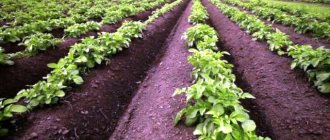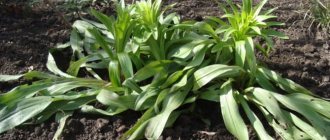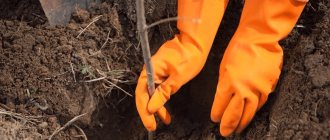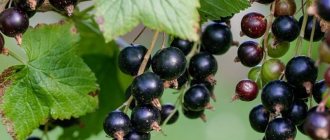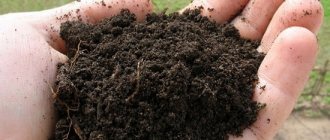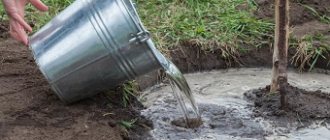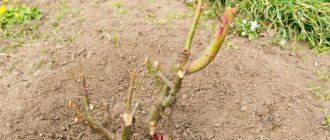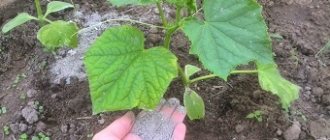Why you need to plant mustard as green manure
The roots and leaves of mustard contain special substances that help cleanse the soil of pathogenic bacteria, viruses, fungal spores and even pest larvae.
This crop is a real godsend for planting in a greenhouse, so as not to import new soil every year. In the break between harvesting and planting seedlings , you can set aside 5-6 weeks to get rid of the infection and feed the soil with organic matter.
Video: Sow mustard in autumn and early spring
Mustard greens accumulate nitrogen, which maintains a slightly acidic soil reaction. This is necessary so that insoluble phosphates dissolve and the plants can feed on them. In an alkaline environment this process is inhibited.
Sowing mustard against weeds in the garden in the fall saves the soil from freezing. It is used as living mulch, which becomes fertilizer by spring. In addition, its deep roots remain in the ground and rot, allowing air and water to penetrate the soil. As a result, the soil becomes loose and easier to process. Digging is not necessary so as not to disturb the microbiological balance of bacteria.
Sowing white mustard as a way to protect against weeds
Many farmers use cut mustard stems as green manure. But most often the plant is used against weeds. White mustard, which has excellent sanitary properties, not only rids the garden of weeds, but also protects crops from many diseases. Proper cultivation of such green manure is a reliable barrier against scab and late blight.
Advantages and disadvantages
Why do gardeners prefer to sow mustard rather than rye or legumes? The advantages of the “bitter doctor” are:
- the ability to improve soil health;
- protection against diseases of potatoes and tomatoes;
- repelling slugs, moths, wireworms;
- the presence of a powerful root system that structures the soil;
- preventing the removal of nitrogen from the soil;
- warming the soil with mowed green mass with the onset of frost.
Mustard is good to plant next to beans and fruit trees. This plant affects the growth of crops and attracts pollinating insects.
To get rid of weeds, white mustard variety is usually used. Sometimes it is called English. Other types of green manure are most often used as fertilizer. The plant is planted in the vacant areas.
In addition to many beneficial properties, mustard has the following disadvantages:
- The plant often suffers from white rust, Alternaria (leaf spot), powdery mildew, and clubroot.
- Mustard needs fairly dense planting. When placed freely, it grows peacefully next to weeds.
- The seeds of the plant attract birds that dig up the soil.
Any type of mustard has antiseptic, antifungal properties, has a burning taste and a pungent aroma. The plant is widely used in medicine, cooking, and agriculture.
Useful properties of the culture
Does mustard help against weeds?
- the rapid growth of the crop does not allow other plants to grow stronger and receive nutrients;
- long roots extract food from the deep layers of the soil, where other crops do not penetrate;
- the plant has lush greenery, which blocks the sun from other weeds and prevents them from developing.
White mustard belongs to the cruciferous family, so cabbage, radishes, radishes and turnips should not be planted after it. These plants can become infected with fungus.
If there are hives with bees on the site, then the amount of honey can be increased, since insects are very fond of mustard pollen.
Characteristics and structure of mustard
Experts classify mustard (Sinapis) as a member of the cruciferous family. It can be divided into 6 types. Especially often used for green fertilizer is white mustard , which is also popularly called English mustard. Its composition helps improve the quality of the soil. Green manure - the plant releases phosphates and other heavily soluble elements from the soil and accumulates them in itself.
Mustard has another important characteristic. It accumulates in all its parts a huge amount of nitrogen compounds, which are so necessary for the development of future crops.
Many crops cannot absorb phosphate substances on their own. After mowing and rotting the mustard, other plants begin to freely absorb difficultly soluble substances. Due to this feature of this organic fertilizer, mustard is used as green manure.
To improve soil fertility, special plants (green manure) are planted for further plowing into the ground. Green manure includes many forage crops:
- sweet clover;
- lupine;
- clover, etc.
Leguminous plants are often planted to plow in green manure.
The influence of organic matter on the soil
If you sow mustard against weeds in the fall, this will affect the fertility of the site. The fact is that organic matter serves as food for soil microorganisms, which in turn produce humus. In this way, you can increase the yield for the next year almost free of charge.
In depleted soils, it is necessary to increase the number of bacteria. For this purpose, preparations of concentrated microorganisms are used. This is Baikal EM-1 and others like it.
Once in the soil, bacteria begin to eat plant residues, at the same time processing insoluble compounds of nitrogen and phosphorus, converting them into a convenient form for plant nutrition. They also use as food those weeds that were unable to germinate thanks to mustard.
Green manure for weeds usually has deep roots, so they are especially necessary on sandy soils. The fact is that water quickly washes away nutrients and crops cannot reach them.
For example, all berry plants have a superficial root system located no deeper than 30 cm from the surface. It is necessary to feed such crops often and little by little. Thanks to mustard, nutrients from the roots rise to the surface and, when decomposed, provide the plants with micro and macroelements.
Growing green manure Mustard
There are no special aspects for growing white mustard. The plant is very unpretentious. Watering is required only in drought conditions, which rarely happens in spring, or in autumn, when green manure is grown.
It also does not require fertilizing.
It is important for us to get green mass before flowering. Therefore, after about a month after planting, the Mustard is mowed.
If you wait until flowering and seed formation, then Mustard, with its active growth, especially after self-sowing, can become the main weed plant in the area.
To dig up the soil or not after sowing green manure
How and when to sow white mustard against weeds to get maximum effect. The main thing is that the plant stems do not become coarse, as they will take longer to decompose. This happens after 7 weeks. At the same time, seeds begin to develop. If you do not cut the mustard before this point, it will be difficult to remove it from the site.
Green manure is often used to renew the soil. It is cheaper and less labor intensive than applying manure. Many summer residents do not know that digging up the soil is harmful, and after green manure there is no need at all.
When digging the soil, bacteria reach the surface and die under the influence of ultraviolet rays. Another variety ends up in deep layers, where it is unable to reproduce.
The soil is usually dug to allow water to penetrate more easily, but mustard roots do this without human intervention. Through the channels remaining after rotting, moisture flows to a great depth - up to 2 meters, so there is no point in wasting energy and time.
When to sow Mustard and how to do it correctly
Since the plant quickly grows and is frost-resistant, Mustard is sowed in early spring, in the fall immediately after harvesting, until October, and before winter snows.
You need to choose sunny or somewhat shaded areas for sowing; the plant does not like shady places.
It is believed that Mustard does not grow well on heavy soils with stagnant groundwater. The acid-base balance of the soil is not critical for the plant.
If Mustard is planted on depleted lands that have not been cultivated before, it is necessary to add humus - two buckets per 1m2.
White Mustard seeds are a very cheap crop (and for this reason it is also popular). 5g is required per 1 m2. seeds
When to sow mustard in spring
Sowing in spring can be done as early as late March, early April, after the ground has thawed. This should be done at least a month before planting the main crops. After about 40-45 days, the Mustard plants begin to bloom, we do not need this. After digging up the green mass of Mustard, at least two more weeks must pass for the formation of a fertile layer of soil.
To plant Mustard, there is no need for deep digging. It is enough to loosen the soil and get rid of large lumps, and level it with a rake. In early spring there is usually no need to moisten the soil before sowing.
Sowing can be done in two ways:
- Plant the seeds in rows, at a shallow depth (1-1.5 cm), pouring a handful into the holes, keeping a distance of 15-20 cm between the rows. In this case, excellent spreading bushes will grow without excessive thickening.
- Sow seeds by broadcasting on a loosened area, then walk with a rake.
The first shoots appear already on the third or fourth day.
Autumn sowing of Mustard
Sowing in the fall by scattering seeds is considered optimal, since it is necessary to create a powerful green layer . Sowing is done immediately after harvesting the main crops, with the obligatory removal of vegetation residues and loosening of the surface layer. Sow within 2-3 days to give no chance to weeds. Before snow falls, it is better to mow the plants and leave them compacted on the soil surface. Thus creating protection for the earth from freezing.
The easiest way to sow in the fall is to plant and forget, and in the spring dig everything up and treat it with phytosporin.
Autumn planting - what is the advantage
Autumn, when mustard seeds are planted against weeds, is the optimal time for greening the site. Over the winter, plant residues have time to rot in the soil and in the spring they are quickly eaten by earthworms and bacteria. Nutrients for seedlings are in the top layer of soil and are available to the roots.
Before the onset of frost, there is no need to cut off the greens, as they themselves die and begin to decompose.
In late autumn, you can sow white mustard so that it germinates only in the spring. The sprouts can withstand frosts down to -5 degrees, so you can prepare the soil a couple of weeks earlier.
After harvesting the garden beds, caring gardeners apply fertilizers to the soil. In this case, you can use mineral mixtures. The mustard root system will use them, and in return the owner will receive organic fertilizer - green manure.
The first step is to choose the right time so that the mustard does not outgrow the allotted time. This is usually early or mid-September. In this case, the crop will have time to grow, but not bloom. Mustard is planted - what to do next:
- cut and lay evenly over all beds;
- leave to rot without cutting;
- cut and compost;
- make mulch under bushes or fruit trees.
There are many options. Some summer residents even give the plant as food to pets and birds.
Gardening tricks
Why is sowing mustard incredibly popular among experienced gardeners and gardeners? This culture has a fungicidal and insecticidal spectrum of effects. It frees farmers from unnecessary digging of the site and fights against plant diseases and harmful insects.
Many gardeners plant main crops directly in rows of slightly grown green manure. When it gains strength and is ready to bloom, it is cut and often left directly on the soil as mulch. This allows you to avoid digging up the beds and enriches the soil with constantly rotting organic matter.
Mustard care
Special care for mustard seedlings is not required, but if the weather is dry or the sowing was done in dry soil, then abundant irrigation must be carried out without fail.
White mustard does not require additional feeding.
After 4-5 weeks, the ground will be densely covered with lush green green manure, and after another week, yellow flowers will begin to appear. Mustard blooms for quite a long time (almost a month), attracting pollinating insects to the garden.
But in the conditions of a summer cottage, mustard is cut before the flowering period, unless it is sown near berry bushes and fruit trees in order to attract bees and bumblebees or for seeds.
Basic rules for using mustard powder
- To ensure that the use of mustard does not harm the plantings, you need to know how to properly process the hot seasoning.
- You can use dry powder in pest control in any weather. Liquid mixtures will bring the desired effect only in the absence of rain, fog and heavy dew.
- It is recommended to spray plants early in the morning or in the evening. Bright sun increases the rate of evaporation of the solution, which can cause burns to plant crops.
- Plants are treated starting from mid-April, making sure that night frosts have ended. At the same time, the air temperature during the day should not fall below +10°C.
- The crop treatment is repeated every 15-20 days. The last time mustard is used is 10 days before harvest.
Using mustard powder wisely, you can protect your crops and achieve high yields without the use of chemicals.
A visual example of how to use mustard
When August ends, the tomato harvest usually occurs, which grows in open ground. At the same time, sow mustard around each bush. When the harvest has already been harvested and it is mid-September, add the vetch-oat mixture to the plant. Leave green manure as far as the temperature allows so that it continues to grow in the winter. In spring, the area is plowed using a cultivator.
What if the plant managed to grow a lot during the fall? Then don’t plow it in, but leave it as mulch. Now water the area with phytosporin, after which you can plant the tomato.
We sow mustard in the fall as fertilizer.
White mustard like green manure - when to sow it in the fall? The months of August and September are suitable for this. So you can leave it for the winter. If the plant has managed to grow well before severe cold, then it is mowed and the soil is cultivated.
Mustard growing in the southern region grows faster. Therefore, it is planted in mid-September or October. A fast-growing plant can germinate even at fairly low temperatures - up to 5 degrees Celsius. At the same time, it partially germinates at plus 2. It is also interesting that when growth occurs, even when the temperature is below zero, the mustard green leaves will continue to grow. They are able to withstand minus 5. If autumn is warm, then a plant sown in October can reach 10 cm in height.
Mustard as a green manure is sown in the fall immediately after the harvest. Do not hesitate with this question, because literally in 3 days weeds will begin to appear.
When is the best time to plant mustard?
This question may concern a young gardener who has not yet encountered this plant. If you use mustard as fertilizer, then the month of April is suitable. As soon as the night frosts have ended and the temperature has reached 10 degrees, you can practice planting.
Planting can also be carried out in the autumn, when all crops are removed from the site. Use the remaining warm days to plant. For example, where there was a place for potatoes or cereals, mustard can be planted. This will allow large areas of soil to become healthier.
It is rare that mustard is planted before winter begins. In some cases this is practical, because then the seeds will grow in the spring. But here it is very important to guess when to plant the plant. The soil should not only be cold, but also well loosened. Do not disturb the seeds until spring, but they should not freeze. How to achieve this? The depth at which you plant the seeds should be sufficient so that they are not washed away by spring meltwater.
It is important to properly treat the soil before planting seeds in it. How to do it? This largely depends on the plant’s predecessors, for example, potatoes or legumes. But whatever the predecessors, the soil must be thoroughly moistened, weeds destroyed and the top layer of soil leveled. Then there is a chance that mustard shoots will be abundant.
Flea control
If such a pest infests your garden, you may be left without a harvest of radishes, cabbage, radishes, daikon, and beets. Cruciferous and beet flea beetles are very persistent insects. But with competent fighting tactics it is possible to completely destroy them. To do this, prepare a mustard infusion:
- Add a glass of mustard powder to a bucket of hot water;
- Mix everything well and leave for 2-3 hours.
Water the beets with the solution from the very first leaves that emerge (when 3-5 appear). Processing is carried out until the fruit ripens.
If the fight against cruciferous flea flea is carried out, then add another glass of 9% vinegar to the solution. The prepared mixture is sprayed onto bushes and plant seedlings.
Cruciferous flea beetle
Mow mustard correctly
How quickly the plant grows largely depends on watering and temperature conditions. Within a month, you will be able to notice a growth of 20 cm. However, if you plan to mow the sprouts, it is important to focus not on growth, but on flowering.
It is very important to mow before flowering occurs. There are at least three reasons for this:
- when flower stalks form, the stems and petioles near the leaves become coarser. As a result, the green mass is not processed so quickly in the soil. It is important that the leaves are tender, then they can quickly become green fertilizer.
- When the mustard begins to bloom, its nutrients, which the soil needs so much, are consumed. The function of green manure is lost. But if you mow it in time, then vegetables and berries will be able to receive the necessary nutrition;
- If mustard has formed seeds, then its reproduction occurs by self-seeding, which turns the necessary plant into an ordinary weed.
When you have already mowed the plant, you need to dig up the area thoroughly. Use a shovel, hoe and flat cutter as tools. In dry weather and rare rains, water the area in a timely manner. Only if the soil is moist will worms and other microorganisms “work” in it.
Vermicompost forms faster and the soil bears fruit better if you use certain additional preparations, for example Baikal EM-1. This product is pretty good. However, it is not suitable for poor, depleted soil. In addition, it does not work well without organic matter - humus and compost. How often does the soil need such humus? At least once every 4 years.
It is not always possible to improve the condition of the soil by sowing mustard. If the soil is sandy and clayey, then the formation of the humus layer is too slow. In this matter, the use of mustard for digging will not work. This option is suitable only when crops alternate and the land is already well developed.
What if you planted mustard, but it did not produce its seeds when growing? Then do not mow it, but leave it for the winter. With the help of a cultivator or a flat cutter in the spring, you can simply dig it up. So it can be used as mulch. However, this option is not as practical as using straw, sawdust and other materials.
